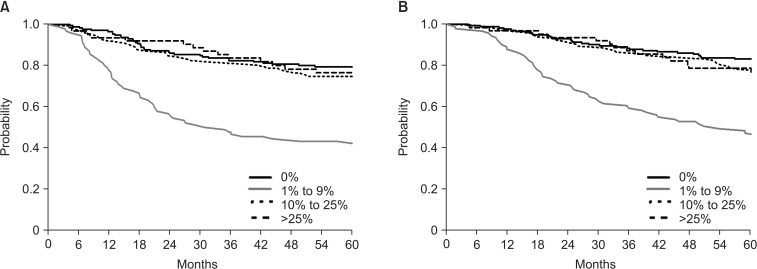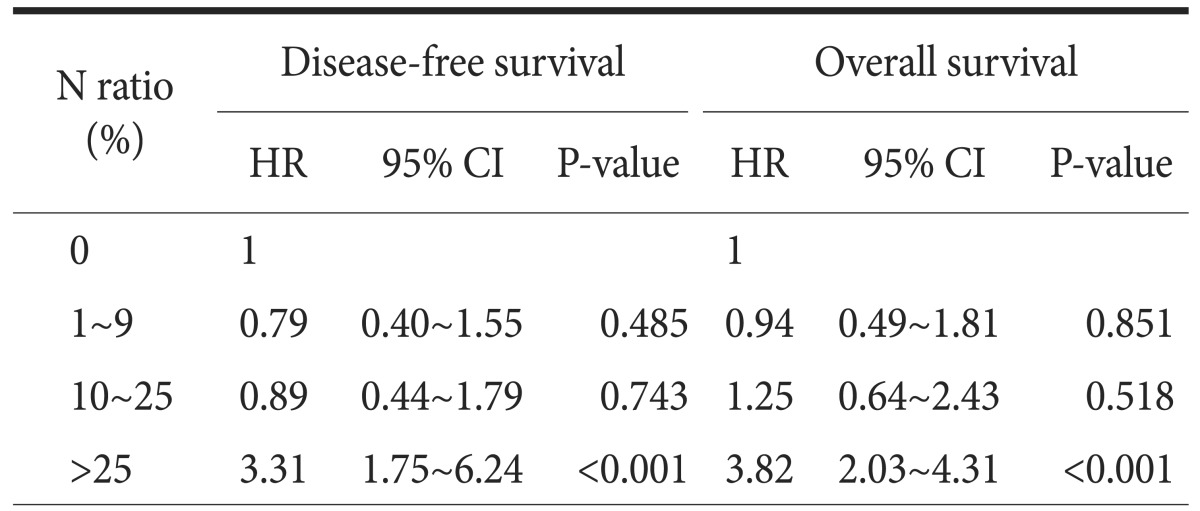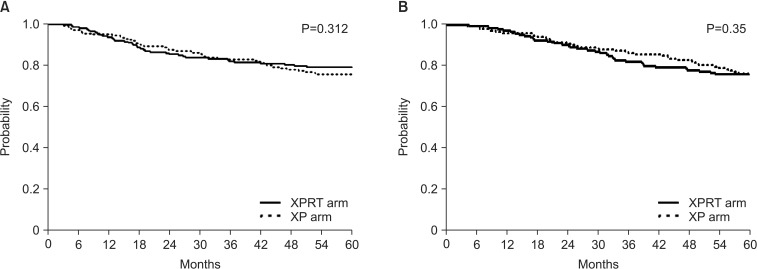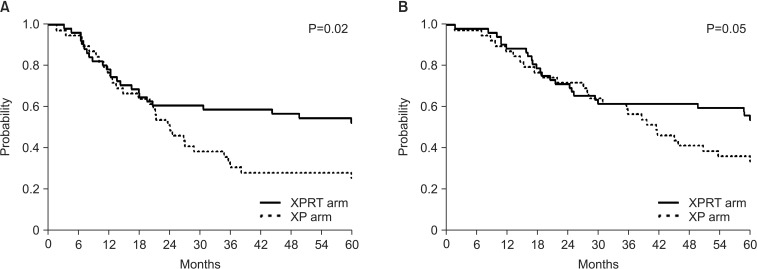Abstract
Purpose
In the Adjuvant Chemoradiotherapy in Stomach Tumors (ARTIST) trial, we investigated whether chemoradiotherapy after D2 gastrectomy reduces the rate of recurrence. Recently, the ratio of metastatic lymph nodes to examined lymph nodes (N ratio) has been proposed as an independent prognostic factor in gastric cancer (GC). The aim of this study was to investigate the relationship between the metastatic N ratio and prognosis of GC after curative D2 surgery.
Materials and Methods
We retrospectively reviewed the data of 458 ARTIST patients who underwent D2 gastrectomy followed by adjuvant chemotherapy (XP, n=228) or chemoradiotherapy (XPRT, n=230). The disease-free survival (DFS) rates of patients were used to evaluate the influence of N ratio on the treatment outcome. To achieve this, 4 different N ratio categories (0%, 1%~9%, 10%~25%, and >25%) were compared on the basis of their influence on the treatment outcome.
Results
On multivariate analysis, the N ratio remained an independent prognostic factor for DFS. The hazard ratios (HRs) for the N ratio categories of 0%, 1%~9%, 10%~25%, and >25% were 1, 1.061, 1.202, and 3.571, respectively. In patients having N ratio >25%, the 5-year DFS rates were 55% and 28% for the XPRT and XP arms, respectively (HR, 0.527; 95% confidence interval, 0.307~0.904; P=0.020).
Conclusions
In patients with curatively resected GC, the N ratio was independently associated with DFS. Although this finding warrants further investigation in future prospective studies, the benefit of chemoradiotherapy for D2 resected GC appears to be more beneficial in cancers having N ratios >25%.
Keywords: Stomach neoplasms, Lymph node, Prognosis
Introduction
Although surgical resection with regional lymph node (LN) dissection is the only curative treatment for patients with gastric cancer (GC), a significant proportion of patients undergoing curative surgery experience disease recurrence that results in poor prognosis. Regional LN dissection performed at the time of curative gastrectomy provides important pathological information for predicting patient prognosis. Although convincing evidence supporting D2 LN dissection is absent in the Western literature,1 this procedure is already considered a standard treatment option in Asian countries such as Korea and Japan. Meticulous LN dissection might not only identify the patients who require adjuvnat chemotherapy owing to the high recurrence risk after surgery,2,3 but might also be curative in some of the patients having positive LNs. In the Adjuvant Chemoradiotherapy in Stomach Tumors (ARTIST) randomized phase III trial,4,5 we compared the outcomes of adjuvant capecitabine/cisplatin (XP) chemotherapy and adjuvant chemoradiotherapy (XPRT) after curative D2 gastrectomy for GC. Although this trial failed to demonstrate an overall difference in disease-free survival (DFS) between the two treatment groups, subgroup analysis indicated that adjuvant XPRT might be more beneficial in patients having LN-positive diseases (3-year DFS, 76% in the XPRT arm vs. 72% in the XP arm; P=0.04).5
Considering the high recurrence rate and poor prognosis associated with GC patients, it is important to identify patients at high risk for recurrence. In addition to LN positivity, the total number of LNs removed, is an indirect measure of the extent of LN dissection, and it serves as an important factor in GC surgery.6 In the light of such findings, some previous studies had recommended the use of the ratio of metastatic LNs to examined LNs (N ratio) as a prognostic factor irrespective of the type of LN dissection performed.7,8 However, these studies were limited by their retrospective nature, and the prognostic value of N ratio has not yet been prospectively addressed. In the present study, we used data obtained from the prospective ARTIST trial to examine the relationship between the N ratio (defined as the number of positive LNs/the total number of LNs removed) and DFS or overall survival (OS) in GC patients who underwent curative gastrectomy with D2 LN dissection.
Materials and Methods
The complete details of the ARTIST trial were previously published elsewhere.4 In brief, 458 patients with pathologic stage Ib–IV (M0) GCs according to the American Joint Committee on Cancer 2002 staging system were randomly assigned to receive adjuvant XP (n=228) or XPRT (n=230). The treatment regimen administered in the XP arm included 6 cycles of 1,000 mg/m2 capecitabine administered twice daily on days 1 to 14 and 60 mg/m2 cisplatin on day 1. Up to 6 cycles of XP was administered every 3 weeks. The treatment regimen administered in the XPRT arm included the concomitant administration of a total radiotherapy dose of 45 Gy and 825 mg/m2 capecitabine twice daily after the completion of two cycles of XP, followed by the administration of two additional cycles of XP. Radiotherapy was administered in daily fractions of 1.8 Gy daily, 5 days per week, over a period of 5 weeks. The ARTIST trial was approved by the institutional review board of the Samsung Medical Center (Seoul, Korea) in accordance with the ethical principles of the Declaration of Helsinki and local guidelines. Written informed consent was obtained from all participating patients before they were randomly assigned to groups.
Surgical specimens were routinely assessed by our dedicated gastrointestinal pathologists. The total number of LNs and the number of positive LNs were reported. At least 15 LNs were removed in 99% of the patients enrolled in the ARTIST trial.5 The N ratios were divided into 4 categories according to the descriptions by Nitti et al.9 and Marchet et al.7 as follows: category 1, 0%; category 2, 1%~9%; category 3, 10%~25%; and category >4, 25%.
The cutoff date for the analysis was September 1, 2013 with a median follow-up duration of 7 years. The Cox proportional hazards model with backward selection was used in the analyses of the correlations between baseline characteristics including the N ratio, and the DFS and OS as endpoints. Individual factors that showed prognostic significance in the univariate analyses were tested for their combined prognostic significance in a multivariate Cox regression model. The variables that were included in the multivariate model for the identification of the prognostic factors of DFS and OS were the age (<56 years vs. ≥56 years); sex (men vs. women); Eastern Cooperative Oncology Group (ECOG) performance status (0 vs. 1); Lauren classification (intestinal vs. diffuse vs. mixed); tumor location (proximal/body vs. antrum vs. multiple/diffuse); type of surgery (subtotal vs. total gastrectomy); LN status (negative vs. positive); stage (I/II vs. III/IV); and the N ratio. The potential presence of an interaction between age and other clinical parameters was tested by defining the product terms for the respective factors in a regression model. The variables that were identified to be insignificant ewre dropped one at a time, beginning with the least significant variable. Survival curves were generated using the Kaplan-Meier method. All P-values were two-sided, and those <0.05 were considered statistically significant. All statistical analyses were performed using the PASW Statistics software version 18.0 (IBM Co., Armonk, NY, USA).
Results
Of the 458 patients enrolled in the ARTIST trial,4 396 cases (85%) were LN-positive and 62 cases (13.5%) were LN-negative (Table 1). All patients underwent curative gastrectomy with D2 LN dissection and subsequently, they were randomly assigned to receive either adjuvant XP (n=228) or XPRT (n=230). The median numbers of LNs removed and LNs involved were 40 cases (range, 12~142 cases) and 3 cases (range, 0~51 cases), respectively. The number of LNs removed did not differ significantly between patients with stage Ib/II and III/IV (M0) disease. The final analyses showed that DFS (hazard ratio [HR], 0.74; 95% confidence interval [CI], 0.52~1.05; P=0.092) and OS (HR, 1.13; 95% CI, 0.78~1.65; P=0.527) for the XPRT and XP arms were similar.5 The 3-year DFS and OS rates were 84% and 87%, respectively, for 62 LN-negative patients, and 74% and 81%, respectively, for 396 patients with LN involvement.
Table 1. Baseline patient characteristics.
Values are presented as median (range), number (%), or number only. XP = capecitabine plus cisplatin; XPRT = concurrent chemoradiotherapy with XP. *According to the 6th Edition of the Joint Committee on Cancer Staging System (2002). †Number of lymph nodes involved/number of lymph nodes removed.
According to the 4-tier classification of the N ratio, the 3-year DFS rates for patients having N ratios of 0%, 1%~9%, 10%~25%, and >25% were 84%, 82%, 81%, and 48%, respectively. The corresponding 3-year OS rates were 87%, 88%, 86%, and 59%, respectively. The Kaplan-Meier curves for DFS and OS are shown in Fig. 1. Considering the similarities in the HRs for DFS and OS endpoints for the N ratio of 0% to 25%(Table 2), we employed a dichotomous classification (i.e., 2-tier, 0%~25% vs. >25%). In the Cox regression analyses of the factors associated with DFS and OS, significant interactions were identified between tumor location and the type of surgery, between stage and LN status, and between LN status and N ratio. The final model adjusted for the differences in clinical characteristics showed that the most significant predictor of recurrence was the N ratio >25% (adjusted HR, 3.44; 95% CI, 2.45~4.83; P<0.001). Similarly, patients with N ratios >25% were more likely to die compared to those having N ratios 0%~25% (adjusted HR, 3.55; 95% CI, 2.49~5.05; P<0.001).
Fig. 1. (A) Disease-free survival curves according to N ratio. (B) Overall survival curves according to N ratio. The cut-off values for the N ratios are as follows: solid (black) line, 0%; dashed line, 1~9%; dotted line, 10~25%; and solid (gray) line, >25%. N ratio = the ratio of metastatic lymph nodes to examined lymph nodes.
Table 2. Disease-free survival and overall survival according to lymph node ratio.
N ratio = the ratio of metastatic lymph nodes to examined lymph nodes; HR = hazard ratio; CI = confidence interval.
In the ARTIST trial,5 significant interactions between the XPRT and XP arms and the N ratio were observed. The DFS rates for the XPRT and XP arms showed no significant differences in patients with N ratios of 0%~25% (HR, 0.80; 95% CI, 0.53~1.23; P=0.312). However, in patients with N ratios >25% (Fig. 2), the DFS in the XPRT arm was significantly longer than that in the XP arm (HR, 0.53; 95% CI, 0.31~0.90; P=0.020). Although less significantly, the OS in the XPRT arm was longer than that in the XP arm for patients with N ratios >25% (HR, 0.58; 95% CI, 0.34~1.00; P=0.052;Fig. 3).
Fig. 2. (A) Disease-free survival curves for patients with N ratios of 0%~25%. (B) Overall survival curves for patients with N ratios of 0%~25%. Solid line, XPRT arm; dotted line, XP arm. XP = capecitabine plus cisplatin; XPRT = concurrent chemoradiotherapy with XP; N ratio = the ratio of metastatic lymph nodes to examined lymph nodes.
Fig. 3. (A) Disease-free survival curves for patients with N ratios >25% (B) Overall survival curves for patients with N ratios >25%. Solid line, XPRT arm; dotted line, XP arm. XP = capecitabine plus cisplatin; XPRT = concurrent chemoradiotherapy with XP; N ratio = the ratio of metastatic lymph nodes to examined lymph nodes.
Discussion
The present study confirmed that the prognostic role of N ratio was independent of the pathological stage of the disease or other prognostic factors in a prospective adjuvant trial. The N stage was not included in the final Cox model due to its significant interaction with the N ratio.10 The results of the analysis strongly suggested that the N ratio provides a model with greater prognostic power than that obtained using the N stage. Our results are consistent with those of previous retrospective studies that reported the N ratio as an effective prognostic tool after D2 gastrectomy in addition to limited LN dissection.7,9,11 Furthermore, we found that patients with N ratios >25% would benefit from the addition of radiotherapy to adjuvant XP chemotherapy.
Surgeons would be more likely to resect a higher number of LNs upon the identification of positive or suspicious LNs during gastrectomy. The likelihood of detecting LN-positive disease increased with an increase in the number of resected LNs; however, this also indicated a higher likelihood for a lower N ratio. Although there is currently no conclusive evidence supporting the use of adjuvant XPRT after D2 surgery, more extensive LN dissection might improve the quality of local control and might better identify the patients who might best benefit from additional XPRT. In the ARTIST trial,5 the median number of LNs removed was 40; however, the range was as wide as 12 to 142. Although the guidelines for GC indicate that at least 15 LNs should be removed,6 it is important to emphasize that the number of LNs removed might vary among surgeons depending on patient selection, the extent of LN dissection, and the number of LNs examined by the pathologists. In fact, the N ratio has also been proposed as a prognostic tool related to LN metastases.9 The principle behind the N ratio arose from a doubt over the impact of extended LN dissection on prognosis and the discussion as to whether better nodal staging might be completely responsible for this effect. The fact that the chances of finding a positive LN was higher for more extensive LN dissection compared to limited surgery,12 led the authors to postulate that the significance of LN stage would vary among the patients depending on the number of LNs removed.
Nitti et al.9 proposed a 4-tier categorization of the N ratio (0%, 1%~9%, 10%~25%, and >25%) and reported that the N ratio was an independent predictor of survival in their series. The findings of the present study indicated that the N ratio could be used in the stratification of the patients after curative D2 gastrectomy. However, the Kaplan-Meier curves for DFS and OS suggested that the previously proposed categorization of the N ratios might be too complicated, which was supported by the lack of a clear distinction between the DFS and OS curves for the N ratios of 0% and 25% after the risk of events plateaued. Not surprisingly, when we tested the association between the N ratio and DFS in 396 patients with LN-positive disease, similar results were obtained. In LN-negative patients (i.e., N ratio=0%), the beneficial effect of extended LN dissection has often been linked to staging that is more accurate. The removal of more LNs might possibly be associated with a more accurate final pathologic N staging; it is well established that patients without LN metastases exhibit much better survival compared to patients with LN involvement. Alternatively, even in patients with pN0 disease, removing more LNs that are negative could result in the clearance of micrometastatic cancer foci that are not detected on pathologic assessment. It is likely that a portion of the improved survival that was observed with extended LN dissection in patients without LN involvement could be attributed to the clearance of these micrometastases.
In GC patients who underwent D2 LN dissection, adjuvant chemotherapy involving either S-1 monotherapy or capecitabine/oxaliplatin combination therapy is considered the standard treatment.2,3 In the ARTIST trial,4,5 XPRT did not significantly reduce recurrence compared to XP alone. However, in subgroup analyses, we found that adjuvant XPRT might be beneficial in patients with LN-positive disease.5 Moreover, our data suggested that the N ratio might be a more useful tool compared to the LN status for selecting patients who can benefit from adjuvant XPRT after D2 surgery. This issue is being addressed in our ongoing multi-institutional ARTIST 2 trial (ClinicalTrials.gov identifier, NCT01761461), which aims to compare the effectiveness of adjuvant S-1 monotherapy to that of S-1/oxaliplatin (SOX) and SOX plus radiotherapy (SOXRT) in 900 patients with LN-positive GC after D2 surgery.
Footnotes
Conflicts of Interest: No potential conflict of interest relevant to this article was reported.
References
- 1.Songun I, Putter H, Kranenbarg EM, Sasako M, van de Velde CJ. Surgical treatment of gastric cancer: 15-year follow-up results of the randomised nationwide Dutch D1D2 trial. Lancet Oncol. 2010;11:439–449. doi: 10.1016/S1470-2045(10)70070-X. [DOI] [PubMed] [Google Scholar]
- 2.Sasako M, Sakuramoto S, Katai H, Kinoshita T, Furukawa H, Yamaguchi T, et al. Five-year outcomes of a randomized phase III trial comparing adjuvant chemotherapy with S-1 versus surgery alone in stage II or III gastric cancer. J Clin Oncol. 2011;29:4387–4393. doi: 10.1200/JCO.2011.36.5908. [DOI] [PubMed] [Google Scholar]
- 3.Noh SH, Park SR, Yang HK, Chung HC, Chung IJ, Kim SW, et al. Adjuvant capecitabine plus oxaliplatin for gastric cancer after D2 gastrectomy (CLASSIC): 5-year follow-up of an open-label, randomised phase 3 trial. Lancet Oncol. 2014;15:1389–1396. doi: 10.1016/S1470-2045(14)70473-5. [DOI] [PubMed] [Google Scholar]
- 4.Lee J, Lim do H, Kim S, Park SH, Park JO, Park YS, et al. Phase III trial comparing capecitabine plus cisplatin versus capecitabine plus cisplatin with concurrent capecitabine radiotherapy in completely resected gastric cancer with D2 lymph node dissection: the ARTIST trial. J Clin Oncol. 2012;30:268–273. doi: 10.1200/JCO.2011.39.1953. [DOI] [PubMed] [Google Scholar]
- 5.Park SH, Sohn TS, Lee J, Lim DH, Hong ME, Kim KM, et al. Phase III trial to compare adjuvant chemotherapy with capecitabine and cisplatin versus concurrent chemoradiotherapy in gastric cancer: final report of the adjuvant chemoradiotherapy in stomach tumors trial, including survival and subset analyses. J Clin Oncol. 2015;33:3130–3136. doi: 10.1200/JCO.2014.58.3930. [DOI] [PubMed] [Google Scholar]
- 6.Ajani JA, Bentrem DJ, Besh S, D'Amico TA, Das P, Denlinger C, et al. Gastric cancer, version 2.2013: featured updates to the NCCN Guidelines. J Natl Compr Canc Netw. 2013;11:531–546. doi: 10.6004/jnccn.2013.0070. [DOI] [PubMed] [Google Scholar]
- 7.Marchet A, Mocellin S, Ambrosi A, de Manzoni G, Di Leo A, Marrelli D, et al. The prognostic value of N-ratio in patients with gastric cancer: validation in a large, multicenter series. Eur J Surg Oncol. 2008;34:159–165. doi: 10.1016/j.ejso.2007.04.018. [DOI] [PubMed] [Google Scholar]
- 8.Costa Junior WL, Coimbra FJ, Batista TP, Ribeiro HS, Diniz AL. Evaluation of N-ratio in selecting patients for adjuvant chemoradiotherapy after D2-gastrectomy. Arq Gastroenterol. 2013;50:257–263. doi: 10.1590/S0004-28032013000400004. [DOI] [PubMed] [Google Scholar]
- 9.Nitti D, Marchet A, Olivieri M, Ambrosi A, Mencarelli R, Belluco C, et al. Ratio between metastatic and examined lymph nodes is an independent prognostic factor after D2 resection for gastric cancer: analysis of a large European monoinstitutional experience. Ann Surg Oncol. 2003;10:1077–1085. doi: 10.1245/aso.2003.03.520. [DOI] [PubMed] [Google Scholar]
- 10.Coimbra FJ, Costa WL, Jr, Montagnini AL, Diniz AL, Ribeiro HS, Silva MJ, et al. The interaction between N-category and N-ratio as a new tool to improve lymph node metastasis staging in gastric cancer: results of a single cancer center in Brazil. Eur J Surg Oncol. 2011;37:47–54. doi: 10.1016/j.ejso.2010.11.002. [DOI] [PubMed] [Google Scholar]
- 11.Kunisaki C, Shimada H, Nomura M, Matsuda G, Otsuka Y, Ono H, et al. Clinical impact of metastatic lymph node ratio in advanced gastric cancer. Anticancer Res. 2005;25:1369–1375. [PubMed] [Google Scholar]
- 12.Lee CM, Park SS, Kim JH. Current status and scope of lymph node micrometastasis in gastric cancer. J Gastric Cancer. 2015;15:1–9. doi: 10.5230/jgc.2015.15.1.1. [DOI] [PMC free article] [PubMed] [Google Scholar]







